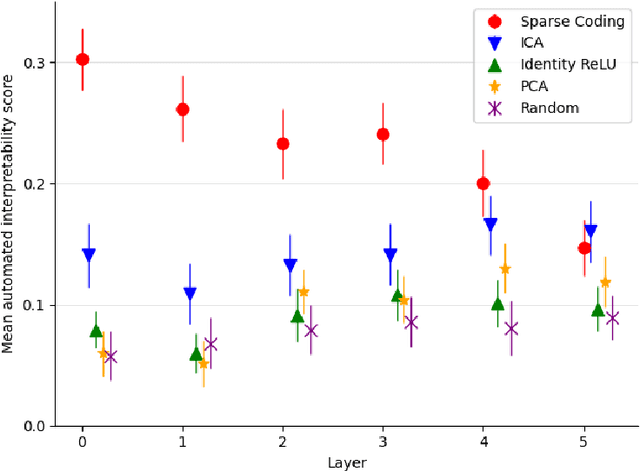Aidan Ewart
Mechanistic Unlearning: Robust Knowledge Unlearning and Editing via Mechanistic Localization
Oct 16, 2024Abstract:Methods for knowledge editing and unlearning in large language models seek to edit or remove undesirable knowledge or capabilities without compromising general language modeling performance. This work investigates how mechanistic interpretability -- which, in part, aims to identify model components (circuits) associated to specific interpretable mechanisms that make up a model capability -- can improve the precision and effectiveness of editing and unlearning. We find a stark difference in unlearning and edit robustness when training components localized by different methods. We highlight an important distinction between methods that localize components based primarily on preserving outputs, and those finding high level mechanisms with predictable intermediate states. In particular, localizing edits/unlearning to components associated with the lookup-table mechanism for factual recall 1) leads to more robust edits/unlearning across different input/output formats, and 2) resists attempts to relearn the unwanted information, while also reducing unintended side effects compared to baselines, on both a sports facts dataset and the CounterFact dataset across multiple models. We also find that certain localized edits disrupt the latent knowledge in the model more than any other baselines, making unlearning more robust to various attacks.
Targeted Latent Adversarial Training Improves Robustness to Persistent Harmful Behaviors in LLMs
Jul 22, 2024Abstract:Large language models (LLMs) can often be made to behave in undesirable ways that they are explicitly fine-tuned not to. For example, the LLM red-teaming literature has produced a wide variety of `jailbreaking' techniques to elicit harmful text from models that were fine-tuned to be harmless. Recent work on red-teaming, model editing, and interpretability suggests that this challenge stems from how (adversarial) fine-tuning largely serves to suppress rather than remove undesirable capabilities from LLMs. Prior work has introduced latent adversarial training (LAT) as a way to improve robustness to broad classes of failures. These prior works have considered untargeted latent space attacks where the adversary perturbs latent activations to maximize loss on examples of desirable behavior. Untargeted LAT can provide a generic type of robustness but does not leverage information about specific failure modes. Here, we experiment with targeted LAT where the adversary seeks to minimize loss on a specific competing task. We find that it can augment a wide variety of state-of-the-art methods. First, we use targeted LAT to improve robustness to jailbreaks, outperforming a strong R2D2 baseline with orders of magnitude less compute. Second, we use it to more effectively remove backdoors with no knowledge of the trigger. Finally, we use it to more effectively unlearn knowledge for specific undesirable tasks in a way that is also more robust to re-learning. Overall, our results suggest that targeted LAT can be an effective tool for defending against harmful behaviors from LLMs.
Eight Methods to Evaluate Robust Unlearning in LLMs
Feb 26, 2024Abstract:Machine unlearning can be useful for removing harmful capabilities and memorized text from large language models (LLMs), but there are not yet standardized methods for rigorously evaluating it. In this paper, we first survey techniques and limitations of existing unlearning evaluations. Second, we apply a comprehensive set of tests for the robustness and competitiveness of unlearning in the "Who's Harry Potter" (WHP) model from Eldan and Russinovich (2023). While WHP's unlearning generalizes well when evaluated with the "Familiarity" metric from Eldan and Russinovich, we find i) higher-than-baseline amounts of knowledge can reliably be extracted, ii) WHP performs on par with the original model on Harry Potter Q&A tasks, iii) it represents latent knowledge comparably to the original model, and iv) there is collateral unlearning in related domains. Overall, our results highlight the importance of comprehensive unlearning evaluation that avoids ad-hoc metrics.
Sparse Autoencoders Find Highly Interpretable Features in Language Models
Sep 19, 2023



Abstract:One of the roadblocks to a better understanding of neural networks' internals is \textit{polysemanticity}, where neurons appear to activate in multiple, semantically distinct contexts. Polysemanticity prevents us from identifying concise, human-understandable explanations for what neural networks are doing internally. One hypothesised cause of polysemanticity is \textit{superposition}, where neural networks represent more features than they have neurons by assigning features to an overcomplete set of directions in activation space, rather than to individual neurons. Here, we attempt to identify those directions, using sparse autoencoders to reconstruct the internal activations of a language model. These autoencoders learn sets of sparsely activating features that are more interpretable and monosemantic than directions identified by alternative approaches, where interpretability is measured by automated methods. Ablating these features enables precise model editing, for example, by removing capabilities such as pronoun prediction, while disrupting model behaviour less than prior techniques. This work indicates that it is possible to resolve superposition in language models using a scalable, unsupervised method. Our method may serve as a foundation for future mechanistic interpretability work, which we hope will enable greater model transparency and steerability.
 Add to Chrome
Add to Chrome Add to Firefox
Add to Firefox Add to Edge
Add to Edge